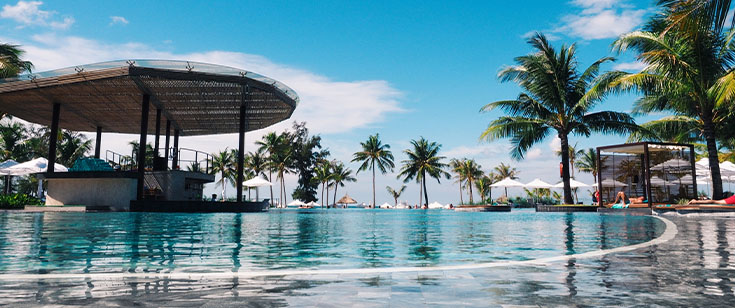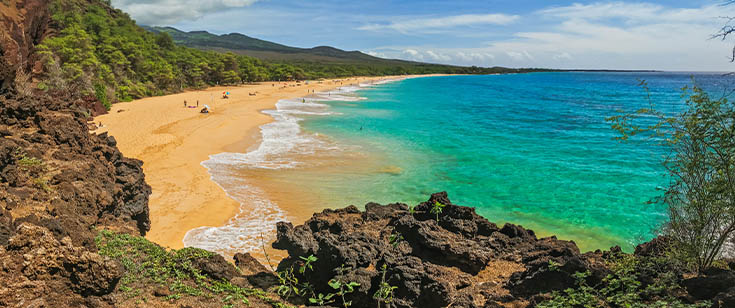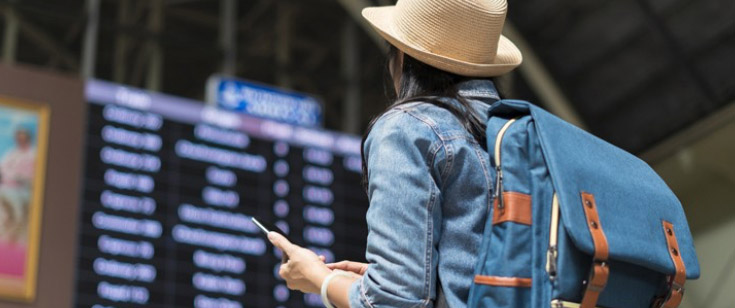Virginia counts more than 400 native and visiting bird species, making it a perfect location for the Bird and Wildlife Trail, which has 65 loops. These 4 sites are favorites among bird lovers.
1. Chincoteague National Wildlife Refuge, Chincoteague
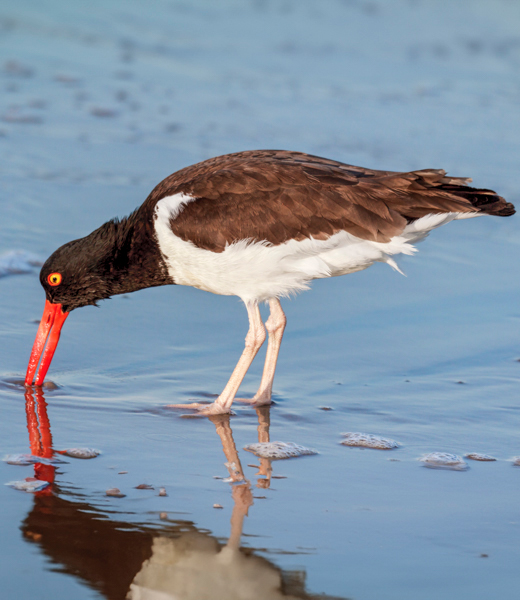
American oystercatchers are frequently spotted at the Chincoteague National Wildlife Refuge. Photo by William Sherman/Getty Images
The Chincoteague National Wildlife Refuge was established more than 80 years ago to protect migrating birds. As part of the Atlantic Flyway (an East Coast bird migration pattern), this bird-watching paradise spans 14,000 acres of habitat for waterfowl, shorebirds, and coastal birds during their annual migrations.
Beaches, dunes, shores, forests, and salt marshes attract more than 300 species annually, including the threatened piping plover, American oystercatchers, and least terns.
Look for raptors in the fall, songbirds on the Woodland trail, and shorebirds year-round along the Atlantic. In the winter, you can spot ducks, Canada geese, snow geese, and tundra swans. In late summer and early fall, shorebird migration is in full swing.
“The mid-Atlantic region and the Eastern Shore often pull in rare birds from the far north, Europe, and our Western states,” says Joanne Laskowski, chair of Birding Eastern Shore. “We’re not sure why it happens, but it’s exciting when it does. In August 2023, Hurricane Idalia blew 2 flamingos into the Chincoteague area, and in October 2022, a tropical kingbird [a bird from southeast Arizona] was found near Oyster.” Vehicle admission, $10.
You may also like: Following the wild ponies of Virginia’s Eastern Shore
2. Kiptopeke State Park, Cape Charles
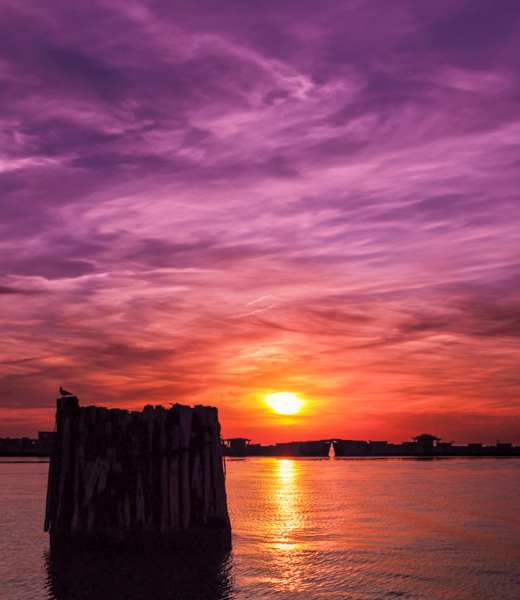
See beautiful sunsets as well as wildlife at Kiptopeke State Park. Photo by Maria Jaeger/Getty Images
The Eastern Shore is home to one of the country’s most important hawk watches, set against stunning views of the Chesapeake Bay. Over several decades, birders have observed 19 species of hawks and more than 1 million individual birds.
Kiptopeke is popular year-round for all kinds of migrating birds. From September through December, it’s one of the best places in the world to spot merlins and peregrine falcons. From early August to late November, the fall migration is particularly popular. Brown pelicans, waterfowl, kestrels, red-tailed hawks, great horned owls, Eastern screech owls, wrens, and several other species might show up.
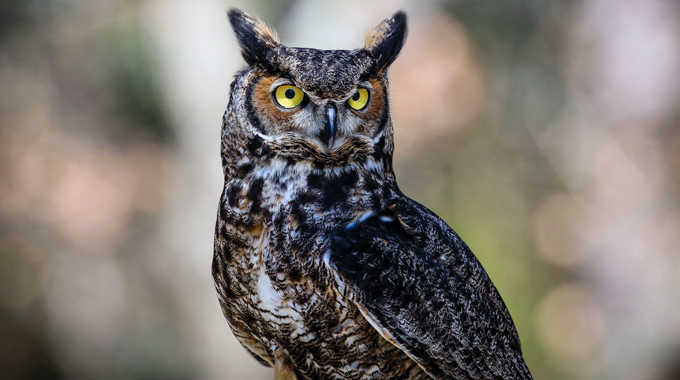
You might see great horned owls at Kiptopeke State Park from early August to late November. Photo by Brian Mumaw/Getty Images
“The narrow peninsula creates a funnel effect as birds migrate south along the Atlantic Flyway during fall migration,” says Roberta Kellam, a founding member and president of Birding Eastern Shore who has birded for more than 5 decades.
According to Kellam, the largest concentration of birds occurs in Northampton County, where 419 species have been spotted. In a typical year, she adds, top birders see more than 200 species.
“It’s amazing to think those little birds are flying thousands of miles between their wintering grounds and summer breeding territories, and they manage to come back to the same patch of habitat from year to year.” Vehicle admission, $7.
You may also like: Fall weekend getaway: 3 perfect days at Cape Charles in Virginia
3. Back Bay National Wildlife Refuge and False Cape State Park, Virginia Beach
Designated more than 85 years ago as a safe habitat for migrating waterfowl, Back Bay National Wildlife Refuge encompasses 9,250 acres on Virginia Beach’s southeastern corner.
Since the refuge doesn’t have a permanent wildlife drive, visitors must walk or bike its 5 trails (8 miles total) to experience the refuge’s beaches, dunes, woods, fields, and freshwater marshes. From April through October, trails connect the refuge with nearby False Cape State Park and its 15 miles of trails.
Guided tram tours also link Back Bay with False Cape, where a narrow barrier spit on the Barbour Hill Trail separates the freshwater marsh, maritime forest, and sand dunes.
“In the spring, shorebirds have their bright and beautiful plumage, whereas in the fall and winter, they’re gray,” says wildlife sculptor and bird-watcher Spencer Tinkham, who often bikes False Cape’s trails.
Fall through spring is Back Bay’s prime time for shorebird viewing—you can see snow geese, tundra swans, ducks, and grebes. Look for nesting species such as least bittern, snowy egret, and glossy ibis. In October, you may spot peregrine falcons. Back Bay vehicle admission, $5; False Cape admission, free.
You may also like: A winter getaway to Virginia Beach
4. Paradise Creek Nature Park, Portsmouth
In 2012, the Elizabeth River Project turned 40 acres of an industrial area into Paradise Creek Nature Park, revitalizing the area’s ecosystem by replacing polluted soil, planting wetland grass for stability, and reintroducing the native Eastern oyster to help filter the water.
Over the past several years, brown pelicans have bounced back from the brink of extinction and birds now flock to the Elizabeth River. Visitors can spot bald eagles, ospreys, and possibly even a pair of peregrine falcons on the park’s bridges.
“An area with a wide variety of birds indicates healthy biodiversity and a variety of sources of food and shelter,” explains Larry Lapell, Paradise Creek’s park manager. “With 169 different species sighted at the park, you’re almost guaranteed to see something unique year-round.”
Once a month the park offers a free 90-minute bird-watching tour along the southern branch of the Elizabeth River that includes 11 acres of restored wetlands. Look for species like great blue herons, egrets, yellow-crowned night herons, red-winged blackbirds, cardinals, jays, robins, Carolina chickadees, and a variety of woodpeckers. Two man-made towers are now home to chimney swifts, a species that has lost most of its natural nesting sites. Park admission, free.
You may also like: Surprising adventures in Virginia state parks
Q&A with sculptor Spencer Tinkham
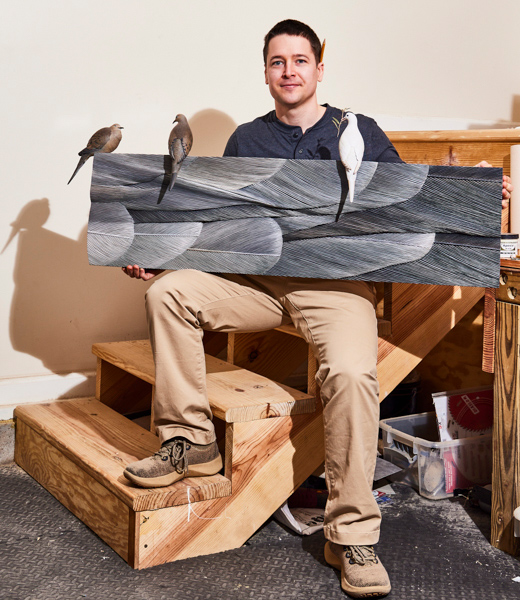
Sculptor Spencer Tinkham with his artwork. Photo by Justin Chesney
Spencer Tinkham is a self-taught wildlife sculptor who creates naturalistic art out of wood with some metal components. Many of his muses are Virginia’s birds.
Where are some of your favorite spots to find birds for inspiration?
I love False Cape State Park and Back Bay Wildlife Refuge, but my favorite area is the Outer Banks—particularly Pea Island National Wildlife Refuge.
How did you become interested in sculpting Virginia’s birds?
I used to live near the end of a creek that was a tributary to the Chesapeake Bay in the Elizabeth River. Hundreds of birds wintered at the end of this creek. I started feeding them and eventually they would recognize me and swarm me when I arrived. Their excitement was contagious. I loved to observe and study them, watching how they interacted. I was ultimately inspired to begin carving them out of wooden scraps from a nearby boat shop in my spare time.
What are you working on now?
I’m working on what I call macro sculptures. It’s like macro photography but in sculpture form. They’re large, highly detailed feather carvings [pictured] full of texture—a deeper dive into birds. I view each as a specimen: Sometimes I go to natural history museums or use online databases to find birds that have intriguing backstories or historical narratives.
Two owls I’m working on were collected from Arlington National Cemetery—one from when it was a military fort and the other from nearly 100 years later, after the owl ran into windows at the Pentagon.
I make quite a few birds that come from Virginia, including some Carolina parakeets, an extinct species that was present in the Tidewater area historically. The challenge is that when you isolate a single feather, sometimes the seemingly boring birds are the most beautiful. I find that I have to put aside my bias and look at birds as if I’ve never really seen them before.
Do you have a favorite piece that you’ve made?
I like every piece I’ve made. My most-exhibited sculpture is an alligator with a mockingbird, which has been in close to a dozen museums. I’ve also made 3 owls with mice in their beaks, as if they’d caught them. Those are also in some great collections. My early decoy work reminds me how far I’ve come: I can see the struggle to push myself out of my comfort zone, not knowing how things will turn out.
What are some of your favorite birds?
I love seabirds. When I hear laughing gulls, it’s kind of the first sign of spring and summer. They have a distinct call that really does sound like a laugh. I also love woodpeckers, especially downy woodpeckers. I like all kinds of birds, really.
Hillary Richard is a New Jersey–based writer and an ardent fan of all things wild and wonderful.
Travel offers & deals
